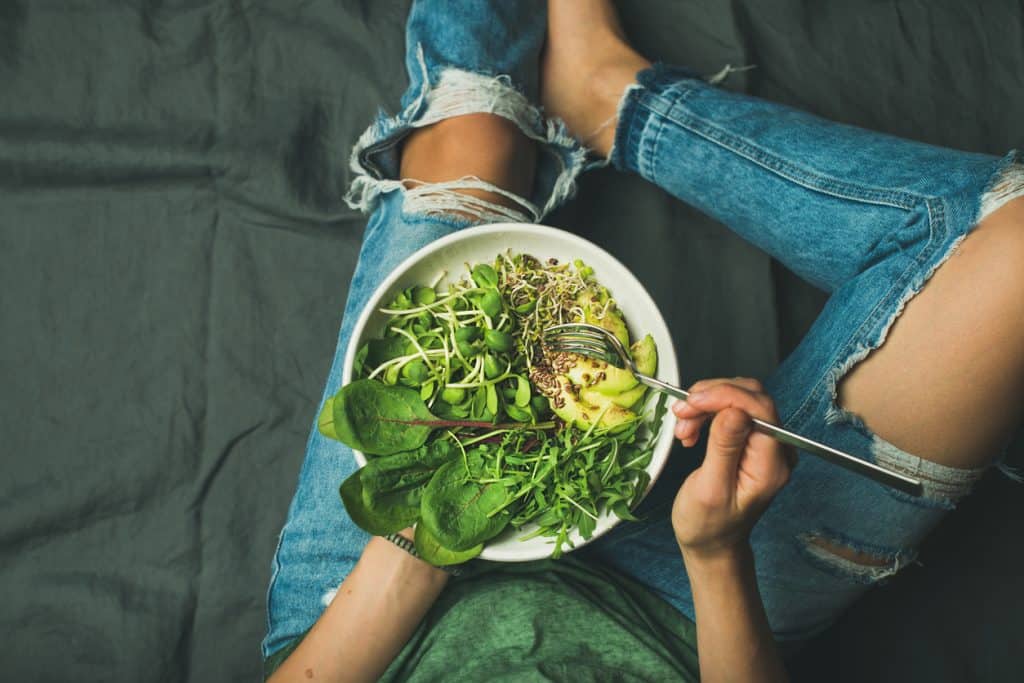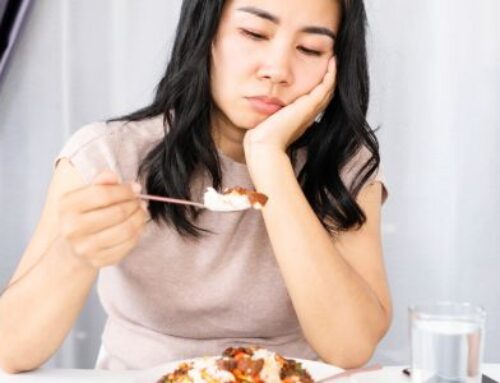
Have you ever felt like you’re struggling to keep the weight off, despite only eating “healthy food”? With so much conflicting nutrition “advice” floating around social and mainstream media, as well as clever marketing and advertising, you could almost be forgiven for being duped into thinking you were doing your waistline a favour by eating some of these less-healthy foods.
It’s always worth remembering that foods don’t instantly become “healthy” just because they’re gluten-free, dairy-free, fructose-free, paleo, ancient, or activated.
These foods can still be very high in calories, which can pose a real problem if your goal is weight management.
Here are my top five “healthy foods” that should really be eaten less frequently if you’re watching your weight.
-
Caesar salad
Salad. It’s likely to be one of the top foods that come to mind when you think of healthy foods. And rightly so – salads can be quite a nutrition powerhouse when you combine a decent serving of vegetables (we’re talking about 2 to 3 cups here!) with lean protein and high-fibre carbs.
But then we have salads like Caesar. And it’s cousin Coleslaw. Don’t even get me started on Pasta and Potato ‘salads’ – we won’t go there today. Caesar salads and Coleslaw definitely ticks the vegetable box but unfortunately the creamy dressing of the salads (and they are often very heavily coated in dressing) make these salads very calorie dense.
Tip: Swapping from a Caesar salad to a less creamy salad such as a Greek salad with a side order of grilled chicken breast will not only provide you with more food, it will also save you some calories!
-
Fruit juices or smoothies
Cold pressed. No added sugar. Organic. Fresh. Fruit juices are all the rage at the moment, and it’s guaranteed to make you feel like you’ve made the right choice by having that freshly pressed “nutritionist” in a bottle. But is it really as good for your weight management goals as it sounds?
A small bottle (350ml) of pure orange juice provides 617kJ and is easily consumed within a minute. It provides little to no feelings of satiety (or fullness in your stomach) which means you could quite easily eat a fairly large meal on top of the juice. In comparison, a standard 230g orange has 285kJ. It has a much higher fibre content, which means you would definitely feel slightly full after eating one. This fullness means you would be less likely to eat as much food as when you drank the fruit juice. Double win!
Smoothies are not much better. A quick analysis of smoothies on offer at a popular health food chain shows that average energy content of a regular smoothie is 2180kJ. That’s a quarter of the daily energy requirements for the average person dedicated to a single drink.
Tip: Stick to vegetable based juices and smoothies with minimal fruit.
-
Sushi rolls
Hailing from a country with such low obesity rates, sushi could be easily mistaken as a healthy food. And some can be, but often sushi rolls don’t contain much vegetables, meaning they are low in fibre and easily consumed in larger quantities. The rice in sushi is often seasoned with sugar, which makes the carbohydrate content of sushi a real nightmare for people with diabetes!
Sushi rolls can also be energy dense depending on what they contain. Deep-fried items such as crispy chicken or tempura fish can easily drive the calorie content up. A quick comparison shows that 2 crispy chicken sushi rolls (1870kJ) contains more calories than most 6-inch subs in Subway’s “6g of Fat or Less” range – and this includes cheese and sauce!
Tip: If having sushi, go for no more than 2 sushi rolls or consider 1 sushi roll and some sashimi (raw fish without the rice and filling). Another option is to fill up on a side salad if you’re still hungry.
-
Sugar-free biscuits
Biscuits made without the ‘evil poison’ that is sugar would surely have to be a healthier choice (note sarcasm). But a quick comparison between Gullon’s Sugar Free Maria biscuits and standard Marie biscuits shows that the calorie difference per biscuit is only 1kcal. The carbohydrate difference was only 1.7g per biscuit, for those interested.
Tip: Treat sugar-free biscuits as you would regular biscuits and eat them sensibly. These are discretionary foods and should not be eaten on a daily basis.
-
“Alternative” chips
Quinoa chips. Brown rice chips. Lentil chips. Harvest snaps (these are green pea shaped twisties!). No longer is the humble potato chip the supreme ruler of the snack aisle!
“These alternatives are made from such wholesome grains. They’re gluten free. They’re all natural. Surely they must be healthier than the standard potato chip?” I hear you ask. The answer is yes, to some degree. Some of these chip alternatives contain a lot more fibre than potato chips. They are often (but not always!) cooked in a healthier fat.
The energy content of these chip alternatives are still high – a 100g serve of most products will provide at least 2000kJ. This makes them nearly as high in calories as regular potato chips.
As always, remember that nutrition requires context. I’m not saying that the above foods are “bad” or “un-healthy” but that they can easily and quickly overshoot your energy budget and lead to weight gain over time. For that reason they should be treated much like other energy dense food options and be eaten in lesser amounts, less often.
If you feel like you’re eating fairly well but not reaping the rewards, it may be time to make your health a priority and seek professional guidance.



